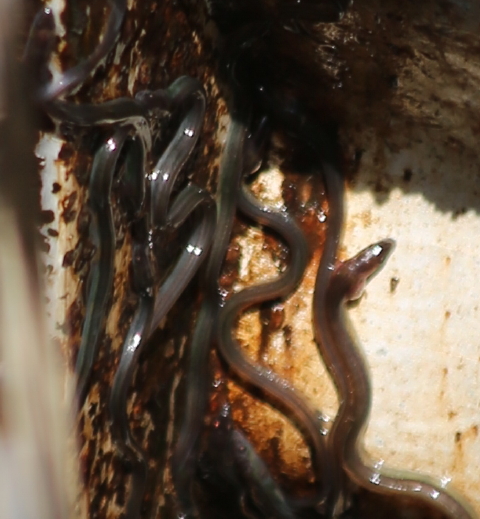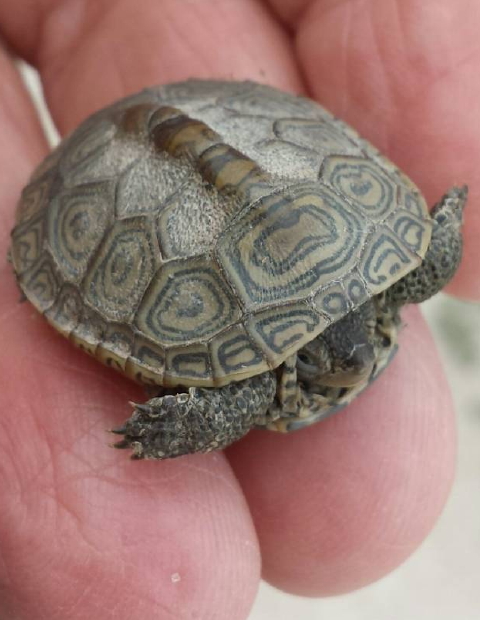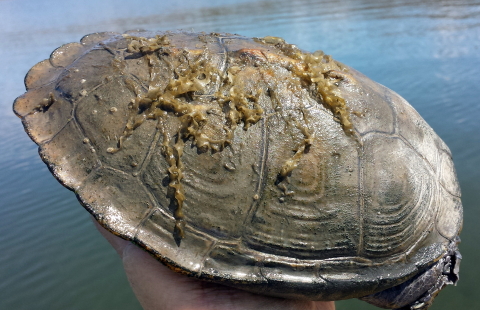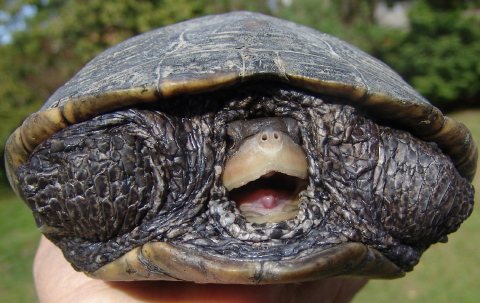Diamondback Terrapin Crashes Tabor Academy Graduation
A curious diamondback terrapin crashed the Tabor Academy graduation this morning. Although uninvited, she snagged the best seat in the harbor, a rock exposed by the receding tide. Â Her rock came with a clear unobstructed view of the festive graduation tent, as well as the Marine Science Center that she helped to build.
 Female Diamondback Terrapin in Sippican Harbor
Turtles rock literally and figuratively, as illustrated by this mature female perched in the middle of Sippican Harbor. Â If anything brought together the leadership of town (Marion) and gown (Tabor Academy), it was the unshakeable belief, stentorianly expressed in a voice akin to that of legendary Foghorn J. Leghorn, “There are NO, I say NO, turtles in Sippican Harbor” … any evidence to the contrary not withstanding. That evidence to the contrary was discovered by Jaeger Chair scholar Sue Wieber Nourse and her advanced marine science students at Tabor Academy beginning in the spring of 2003.
Boston Globe Coverage of Tabor Academy Terrapin Research
(Click Each Page to Enlarge)
As reported in the Boston Globe in December 2003, Sue Wieber Nourse’s breakthrough results led to a prestigious National Fish & Wildlife grant to export her hands-on research methodologies nationally. Â Her work also formed an illustrative practicum for the National Science Foundation’s COSEE (Centers for Ocean Science Education Excellence) initiative. Â This signature marine science research program at Tabor Academy enlisted a consortium of SouthCoast and Cape Cod partners that included the NMFS Science Aquarium in Woods Hole, the National Marine Life Center, the Massachusetts Audubon Society, the Buttonwood Park Zoo and the Lloyd Center for the Environment.
Wieber Nourse’s Tabor Students Locate Endangered Turtle Nesting Site
(Click Article to Enlarge)
Under Sue Wieber Nourse’s guidance, advanced marine science students at Tabor Academy’s Schaefer Oceanology Lab scoured local barrier beaches and salt marsh systems to locate nesting sites and nursery habitat for elusive diamondback terrapins. Â None had ever been discovered on the SouthCoast of Massachusetts. Â Her students soon identified a major nesting site off Buzzards Bay, and documented its presence and importance with Massachusetts Natural Heritage and Endangered Species Program (NHESP). Going through this formal research and documentation process ensures that vulnerable habitat is preserved, while at the same time, teaching students through personal hands-on actions what is required to effectively save endangered species and fragile habitat.
Tabor Students Involved in University-Level Research
(Click Article to Enlarge)
While Sue Wieber Nourse held the Jaeger Chair, Tabor Academy remained the only secondary school in the nation engaged in such high level field research, analogous to ongoing studies at Hofstra University, University of Georgia, Davidson College, University of Texas, Virginia Institute of Marine Science, and several other colleges and universities on the Atlantic Coast. This celebrated marine science research breathed life into Tabor Academy’s slogan as the School by the Sea.
New Bedford Standard Times Front and Back Page Coverage
(Click on Each Page to Enlarge)
By the Fall Semester 2004, the terrapin research program began to reap conservation dividends. Â Nests that students discovered in the Spring Semester were covered with predator excluders, and the turtle eggs had incubated in warm sand through the long, hot summer days. Â In September, Sue Wieber Nourse’s new marine science students savored the unique experience of watching baby terrapins hatch, putting an exclamation point on the success of this powerful and innovative research program. Â An exciting educational discovery transforms into a significant conservation event through the magic of hands-on learning.
Marine Science Center Opened in Fall 2005
Entering its third research season with a now well established national reputation, the diamondback terrapin research program transitioned from the old Schaefer Oceanology Lab to the newly opened marine science center, dubbed by Tabor Academy as the Center for Marine and Nautical Sciences. Spotlighting the critical importance of hands-on research as a highly effective tool in sparking a lifelong scientific curiosity within students, Sue Wieber Nourse keynoted the dedication of the center. Â At the same ceremony, she received the Jaeger Chair for Marine Studies in recognition of her outstanding accomplishments on behalf of Tabor Academy and for her national leadership in science education.
The diamondback terrapin research program ended at Tabor Academy in June 2008 when Sue Wieber Nourse received a year-long sabbatical, during which she co-founded Turtle Journal and subsequently assumed executive leadership of Cape Cod Consultants where she continues her breakthrough work in marine science research, environmental assessments, wildlife rescues, sensitive habitat restoration, endangered species conservation, and hands-on educational experiences in both formal and informal settings.







































